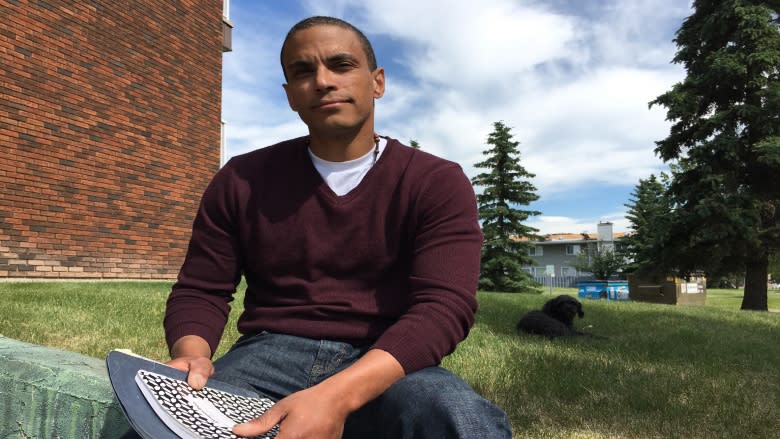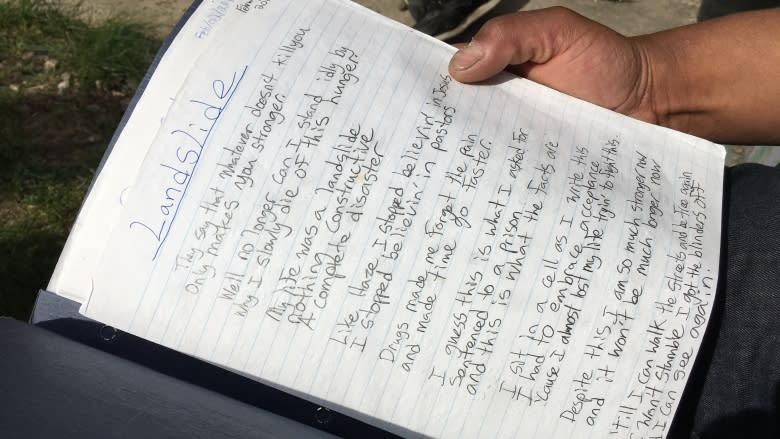Solitary confinement under scrutiny as Ottawa moves to limit use of controversial practice
Locked up in solitary confinement for 43 days last year at the maximum security Edmonton Institution, Matthew Hamm's only view of the world outside his cell was through a mail slot.
And even then the only thing he could see was a brick prison wall.
"It's complete loneliness and there's a lack of hope and it just sucks the life out of you," Hamm told CBC News.
Hamm, who was serving time for robbery, endured several stints in what he calls "the hole" over a total of about 15 years behind bars in his life.
Now released from prison, he's watching new developments closely as the Canadian government works toward limiting the length of time prisoners can be held in solitary.
"It's basically hell on earth," the 38-year-old said, explaining the isolation made him feel desperate and powerless.
Government proposes 15-day limit
The practice of segregating prison inmates for long stretches is set to change as Canada attempts to fall in line with new United Nations rules introduced in 2015.
Known as the Nelson Mandela Rules after the late South African president who spent 27 years in prison, the guidelines set standards for limits on the use of solitary confinement.
A bill tabled June 19 in the House of Commons sets the framework to limit the time a federal prisoner can be held in solitary confinement to 15 days.
The changes proposed in Bill C-56 come after a number of high-profile suicides by prisoners who were locked away for long periods of segregation.
"We're moving away from it," Public Safety Minister Ralph Goodale said of the tactic, adding no prisoner should ever be in segregation if they have mental health issues.
In September 2014, the Office of the Correctional Investigator of Canada reported that 14 prisoners died by suicide while in segregation in federal institutions between April 2011 and March 2014. Ten of the 14 had been held in segregation for longer than 15 days.
There were other high-profile suicides in the years before that, including 24-year-old Edward Snowshoe, who took his own life at the Edmonton Institution in August 2010 after spending more than five months in segregation.
His mother, who didn't know her son had been in such restrictive conditions until a fatality inquiry several years later, has been fighting for change ever since.
"I wished they would have done that years ago, instead of my son being in there for 162 days," Effie Snowshoe said of the government's move to limit the use of segregation.
Still distraught about what happened to her son, she wants an end to solitary confinement.
In an interview last week, correctional investigator Ivan Zinger described the length of time Edward Snowshoe was in segregation as "an awful long time for anybody."
Prisoners still in solitary for long stretches
But long stretches of segregation are still a reality for some Canadian prisoners.
As of June 22, one prisoner had spent 168 days in solitary confinement in a cell somewhere in Corrections Canada's Prairie region, which stretches between Alberta and northwestern Ontario. The prison service won't reveal exactly where the inmate is being held, citing privacy reasons.
Institutions in the Prairie region are holding more inmates in segregation than any other region. As of May 15, nine inmates in the region had been in segregation for more than 100 days.
Of the total 141 inmates in segregation in the Prairie region as of May 15, only 57 were there for 15 or fewer days.
Chris Hay, executive director of the John Howard Society of Alberta, said the society is troubled by any term in solitary confinement that goes beyond the UN's suggestion of 15 days.
"We wouldn't want to see someone in for 20 or 25 days, let alone 160," Hay said. The John Howard Society provides programs for offenders and former offenders and advocates for changes in the criminal justice system.
In a statement to CBC News, the Correctional Service of Canada said it does not put prisoners in segregation as punishment. The measure is used when there are no alternatives or when it is deemed necessary for safety and security reasons, it said.
Within five days, the service said, inmates in segregation get access to TVs, stereos and books. The statement said inmates in segregation get exercise time and can request to see a chaplain or an elder. They are seen daily by a nurse and the institutional head.
Segregated inmates have access to a shower every second day and are allowed to continue studying for educational and correctional programs.
Ex-prisoner still dreams he's in solitary
But Matthew Hamm, who was released from prison on May 22, said the practice is used far too much. He says he still wakes up at night after dreaming he's still in isolation.
And he still can't believe he did 43 days in solitary on the strength of information from another inmate who said he and some friends had a plot to harm guards.
Locked up for what he says was as much as 23 hours a day, Hamm used a soft pencil and some paper to craft his own legal argument.
Using a rules-of-court book he had asked for, he figured out how to write motions and applications, finally getting his case in front of a Queen's Bench justice who agreed that his segregation was unreasonable.
Pointing out that no institutional charges had been laid in spite of the serious nature of the allegations against Hamm, the judge ordered that he be placed back into the prison's general population.
Hamm and two other inmates are suing the Attorney General of Canada for $1.87 million each in damages, arguing prolonged segregation is detrimental to inmates' physical, psychological, social and spiritual health.
A statement of defence denies the spell in segregation caused any issues, arguing the well-being and health of segregated inmates is always monitored.
Now that he's out, Hamm continues to fight the system on behalf of others who are still behind bars.
"I'd like to see solitary confinement completely outlawed because it's a detriment to our society," he said.
He said being free from prison, and loved by his Edmonton family, feels like paradise every day.
And he vows not to wind up incarcerated again, insisting the drug problems that got him into trouble are behind him.
"There's nothing I could ever do that would risk my freedom. I'm afraid to jaywalk."




